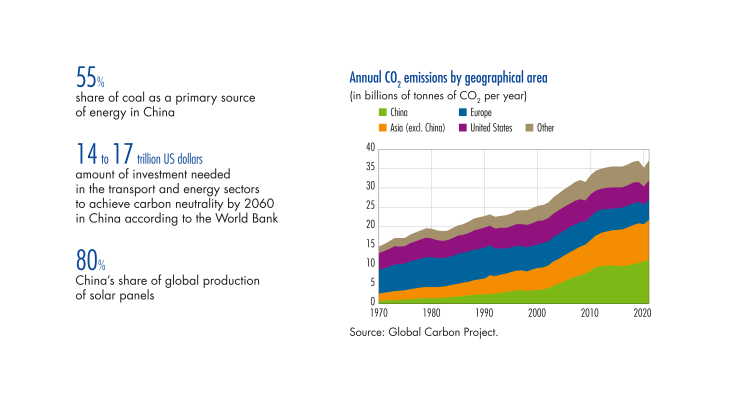1. An unsustainable growth model in the context of climate change
Since the start of economic reforms in 1978, China has experienced a phase of development and strong growth. Between 2001 and 2021, its population grew by around 200 million, and its GDP soared by a factor of almost 15. This rapid development has been largely driven by an exceptionally high level of investment, which averaged 41 % of GDP over the period. This share is twice as high as in the European Union or the United States, particularly in construction and manufacturing. The large allocation of investment to the most energy intensive sectors, combined with an industrial base that is less efficient than in developed countries, has resulted in highly energy intensive economic growth. Against this backdrop of sustained, rather extensive, growth and highly energy intensive GDP, China’s energy consumption has risen considerably over the past two decades (see Chart 1).
The impact on greenhouse gas emissions is assessed according to the energy source used. To meet this demand, China’s energy mix has been, and remains, heavily dependent on coal (55 % of the total in 2021 – see Chart 2 – compared with 11 % in the United States, for example). By 2022, coal production had reached an all time high at over 4.5 billion tonnes, i.e. a 4.5 fold increase since the beginning of the century. Despite concerns about air quality and China’s commitment to decarbonisation, coal mining is therefore a dynamic activity. It continues to fuel an industrial ecosystem, which is concentrated in the north east of the country and which is similar to those in the coal mining regions of Europe during the industrial revolution. Managing decarbonisation will be all the more complex as the regime’s productivist ideology has been associated with this industrial ecosystem since the 1980s and as energy independence argues in favour of maintaining coal. Non carbon energies are thus making their way into the energy mix, but they are still a minority (16 % of energy sources in 2021). As a result of this high carbon mix, combined with highly energy intensive growth, China emits three times more CO2 for each unit of GDP produced than the United States (and more than six times more than France). With a GDP equivalent to 18 % of world GDP, China accounted for 31 % of global CO2 emissions in 2021 (see Chart 3).
[to read more, please download the article]
